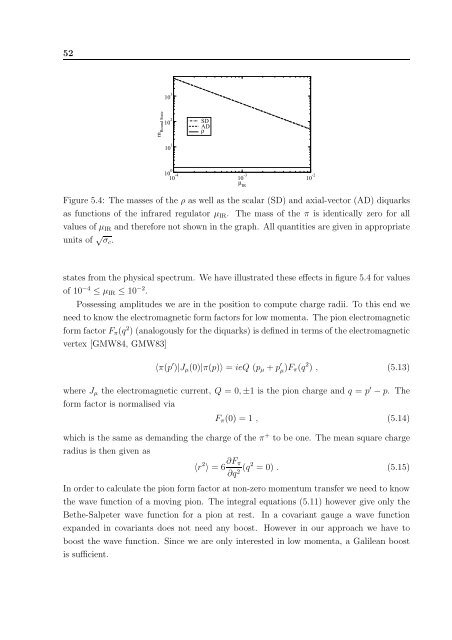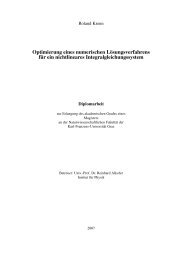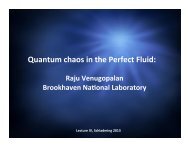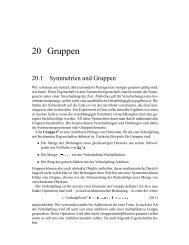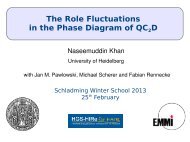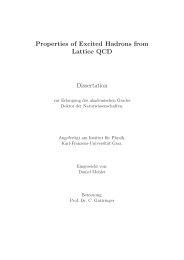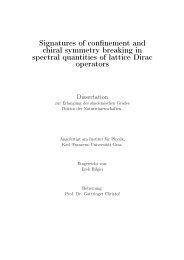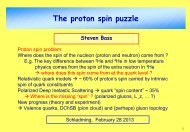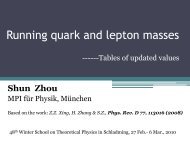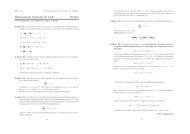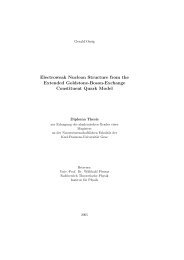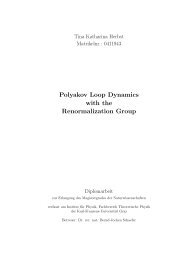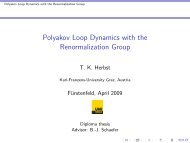The QCD Quark Propagator in Coulomb Gauge and - Institut für Physik
The QCD Quark Propagator in Coulomb Gauge and - Institut für Physik
The QCD Quark Propagator in Coulomb Gauge and - Institut für Physik
You also want an ePaper? Increase the reach of your titles
YUMPU automatically turns print PDFs into web optimized ePapers that Google loves.
52<br />
10 3<br />
m Bound State<br />
10 2<br />
10 1<br />
SD<br />
AD<br />
ρ<br />
10 0<br />
10 -4 10 -3 10 -2<br />
µ IR<br />
Figure 5.4: <strong>The</strong> masses of the ρ as well as the scalar (SD) <strong>and</strong> axial-vector (AD) diquarks<br />
as functions of the <strong>in</strong>frared regulator µ IR . <strong>The</strong> mass of the π is identically zero for all<br />
values of µ IR <strong>and</strong> therefore not shown <strong>in</strong> the graph. All quantities are given <strong>in</strong> appropriate<br />
units of √ σ c .<br />
states from the physical spectrum. We have illustrated these effects <strong>in</strong> figure 5.4 for values<br />
of 10 −4 ≤ µ IR ≤ 10 −2 .<br />
Possess<strong>in</strong>g amplitudes we are <strong>in</strong> the position to compute charge radii. To this end we<br />
need to know the electromagnetic form factors for low momenta. <strong>The</strong> pion electromagnetic<br />
form factor F π (q 2 ) (analogously for the diquarks) is def<strong>in</strong>ed <strong>in</strong> terms of the electromagnetic<br />
vertex [GMW84, GMW83]<br />
〈π(p ′ )|J µ (0)|π(p)〉 = ieQ (p µ + p ′ µ )F π(q 2 ) , (5.13)<br />
where J µ the electromagnetic current, Q = 0, ±1 is the pion charge <strong>and</strong> q = p ′ − p. <strong>The</strong><br />
form factor is normalised via<br />
F π (0) = 1 , (5.14)<br />
which is the same as dem<strong>and</strong><strong>in</strong>g the charge of the π + to be one. <strong>The</strong> mean square charge<br />
radius is then given as<br />
〈r 2 〉 = 6 ∂F π<br />
∂q 2 (q2 = 0) . (5.15)<br />
In order to calculate the pion form factor at non-zero momentum transfer we need to know<br />
the wave function of a mov<strong>in</strong>g pion. <strong>The</strong> <strong>in</strong>tegral equations (5.11) however give only the<br />
Bethe-Salpeter wave function for a pion at rest. In a covariant gauge a wave function<br />
exp<strong>and</strong>ed <strong>in</strong> covariants does not need any boost. However <strong>in</strong> our approach we have to<br />
boost the wave function. S<strong>in</strong>ce we are only <strong>in</strong>terested <strong>in</strong> low momenta, a Galilean boost<br />
is sufficient.


